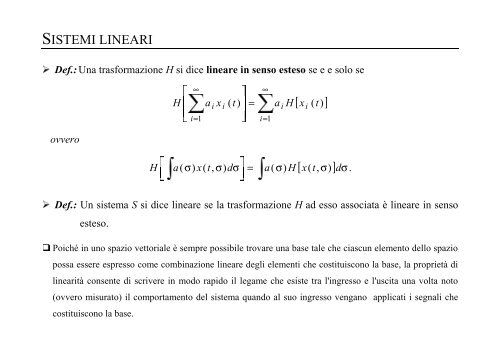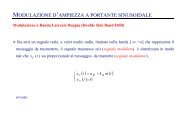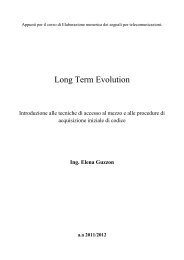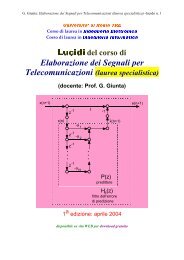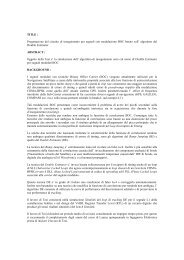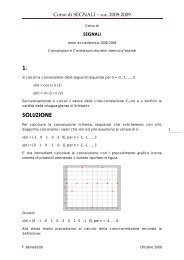- Page 1 and 2: FACOLTÀ DI INGEGNERIA CORSI DI STU
- Page 3 and 4: LA COMUNICAZIONE Nello studio dei s
- Page 5 and 6: FORMA D'ONDA La descrizione più na
- Page 7 and 8: SEGNALI TEMPO CONTINUO Def.: Si def
- Page 9 and 10: vantaggio della rappresentazione ge
- Page 11: TRASFORMAZIONI LINEARI Def.: Una tr
- Page 15 and 16: SISTEMI LINEARI E PERMANENTI A TEMP
- Page 17 and 18: SISTEMI LINEARI A TEMPO DISCRETO In
- Page 19 and 20: RISPOSTA IMPULSIVA Dato un segnale
- Page 21 and 22: CONVOLUZIONE DISCRETA L'operatore c
- Page 23 and 24: ⎩ ∫ ⎨ b ⎧ f ( t ) u0 ( t
- Page 25 and 26: Commento: Di conseguenza, dal punto
- Page 27 and 28: Proprietà fondamentali: i. propri
- Page 29 and 30: RISPOSTA IMPULSIVA Dato un segnale
- Page 31 and 32: INTEGRALE DI CONVOLUZIONE L'operato
- Page 33 and 34: CONVOLUZIONE: PROPRIETÀ associati
- Page 35 and 36: CONVOLUZIONE: PROPRIETÀ distribut
- Page 37 and 38: CONVOLUZIONE: PROPRIETÀ 1. ) ( ) (
- Page 39 and 40: Per dimostrare la necessità si oss
- Page 41 and 42: PRODOTTO SCALARE Def.:Un'applicazio
- Page 43 and 44: SPAZI DI HILBERT Uno spazio vettori
- Page 45 and 46: SEGNALI DI ENERGIA Esercizio: Si c
- Page 47 and 48: SEGNALI DI POTENZA Def.: Dato un se
- Page 49 and 50: SEGNALI DI POTENZA Esercizio: Si c
- Page 51 and 52: PRODOTTO SCALARE PER SEGNALI DI ENE
- Page 53 and 54: T t T T ∫ Δ / 2 lim ( ) Δ →
- Page 55 and 56: inoltre i. è distributivo rispetto
- Page 57 and 58: ORTOGONALITÀ Def.: due elementi di
- Page 59 and 60: INTERCORRELAZIONE Def.1: dati due s
- Page 61 and 62: CORRELAZIONE per x(t)=y(t) la funz
- Page 64 and 65:
TRASFORMAZIONI LINEARI ED INTERCORR
- Page 66 and 67:
TRASFORMAZIONI LINEARI ED INTERCORR
- Page 68 and 69:
TRASFORMAZIONI LINEARI ED INTERCORR
- Page 71 and 72:
p x 1 y 1 ( t ) = p x x ( t ) ∗ h
- Page 73 and 74:
p ⎡ ⎢ ⎣ y 1 y 2 lim ΔT →
- Page 75 and 76:
TRASFORMAZIONI LINEARI ED INTERCORR
- Page 77 and 78:
SEGNALI PERIODICI Def.: Dato un se
- Page 79 and 80:
SVILUPPO IN SERIE DI FOURIER PER SE
- Page 81 and 82:
SVILUPPO IN SERIE DI FOURIER PER SE
- Page 83 and 84:
∫ ∫ ∫ ∫ − − ∞ → −
- Page 85 and 86:
SERIE DI FOURIER PER SEGNALI PERIOD
- Page 87 and 88:
SERIE DI FOURIER PER SEGNALI PERIOD
- Page 89 and 90:
TEOREMA DI PARSEVAL PER SEGNALI PER
- Page 91 and 92:
xn = = = ⎡ ⎢ ⎢ ⎢ ⎢ ⎣
- Page 93 and 94:
x n = = = 1 T 1 T + ∫ ∫ T / 2
- Page 95 and 96:
SVILUPPO IN SERIE DI FOURIER PER SE
- Page 97 and 98:
X n ⎞ ⎛ n ⎜ sin ⎟ π Δ Δ
- Page 99 and 100:
x 2 (t ) x (t ) t
- Page 101 and 102:
x 4(t ) x (t ) t
- Page 103 and 104:
pxx + ∞ + ∞ ( τ ) = e T = u (
- Page 105 and 106:
c.d.d. + ∞ 1 p yy gg ππ gg 0 T
- Page 108 and 109:
TRASFORMATA DI FOURIER PER SEGNALI
- Page 110 and 111:
TRASFORMATA DI FOURIER PER SEGNALI
- Page 112 and 113:
TRASFORMATA DI FOURIER PER SEGNALI
- Page 114 and 115:
Commento: la trasformata qui deriva
- Page 116 and 117:
Prova: F + ∞ { x( t − τ) } = x
- Page 118 and 119:
TRASFORMATA DI FOURIER PER SEGNALI
- Page 120 and 121:
TRASFORMATA DI FOURIER PER SEGNALI
- Page 122 and 123:
TRASFORMATA DI FOURIER PER SEGNALI
- Page 124 and 125:
Inoltre, essendo il segnale derivat
- Page 126 and 127:
Prova: Sia ( ) ( ) ( ) ( ) ( ) ( )
- Page 128 and 129:
TRASFORMATA DI FOURIER PER SEGNALI
- Page 130 and 131:
TRASFORMATA DI FOURIER PER SEGNALI
- Page 132 and 133:
Commento: Segnali che differiscono
- Page 134 and 135:
Prova: Dati due segnali impulsivi x
- Page 136 and 137:
TRASFORMATA DI FOURIER PER SEGNALI
- Page 138 and 139:
TRASFORMATA DI FOURIER PER SEGNALI
- Page 140 and 141:
Prova: Y ( + jψ − jψ ) ( f ) =
- Page 142 and 143:
H( f ) DTE MODEM MODEM DTE -f 0 X(
- Page 144 and 145:
TRASFORMATA DI FOURIER PER SEGNALI
- Page 146 and 147:
Si dice Energia di un segnale impul
- Page 148 and 149:
TEOREMA DI WIENER Teorema di Wiene
- Page 150 and 151:
TEOREMA DI WIENER Teorema di Wiener
- Page 152 and 153:
TEOREMA DI WIENER Teorema di Wiene
- Page 154 and 155:
TRASFORMATA DI HILBERT { } Def. Dat
- Page 156 and 157:
TRASFORMATA DI HILBERT Teorema: dat
- Page 158 and 159:
TRASFORMATA DI HILBERT x(t)=cos(2
- Page 160 and 161:
Dim. Dalla (1) segue che se x(t) è
- Page 162 and 163:
INVILUPPO COMPLESSO Def. Dato un se
- Page 164 and 165:
SEGNALE ANALITICO E INVILUPPO COMPL
- Page 166 and 167:
Inoltre per la sua Trasformata di H
- Page 168 and 169:
INVILUPPO COMPLESSO (SEGUE) Teorema
- Page 170 and 171:
TRANSITO IN UN SISTEMA LINEARE Sia
- Page 172 and 173:
MODULAZIONE D’AMPIEZZA A PORTANTE
- Page 174 and 175:
MODULAZIONE D’AMPIEZZA BLD Poich
- Page 176 and 177:
MODULAZIONE D’AMPIEZZA BLD A seco
- Page 178 and 179:
MODULAZIONE D’AMPIEZZA BLU (O SSB
- Page 180 and 181:
MODULAZIONE D’AMPIEZZA BLU (O SSB
- Page 182 and 183:
DEMODULAZIONE SINCRONA (O COERENTE,
- Page 184 and 185:
Il segnale xM(t) risulta dalla sovr
- Page 186 and 187:
-f p -f e -f I -f M Detti segnali v
- Page 188 and 189:
x (t ) x (t ) - t
- Page 190 and 191:
MODULAZIONE ANGOLARE Le componenti
- Page 192 and 193:
DEMODULATORE A DISCRIMINATORE { } {
- Page 194 and 195:
MODULAZIONE DI FREQUENZA Poiché jb
- Page 196 and 197:
MODULAZIONE DI FREQUENZA L'invilupp
- Page 198 and 199:
TEOREMA DI SHANNON Teorema di Shann
- Page 200 and 201:
cdd. x = () t = x n ∑ ∑ x n n n
- Page 202 and 203:
⎡ ⎤ ⎛ ⎞ ⎛ ⎞ ⎜ ⎟ ⎜
- Page 204 and 205:
TEOREMA DI SHANNON: CAMPIONAMENTO
- Page 206 and 207:
TEOREMA DI SHANNON: SOTTOCAMPIONAME
- Page 208 and 209:
TEOREMA DI SHANNON: SOVRACAMPIONAME
- Page 210 and 211:
TRANSITO DI UN SEGNALE LIMITATO IN
- Page 212 and 213:
d’onda d’ingresso, calcolino i
- Page 214 and 215:
TEOREMA DI SHANNON: APPLICAZIONI T
- Page 216 and 217:
TEOREMA DI SHANNON: APPLICAZIONI Si


